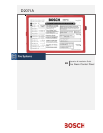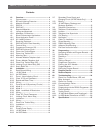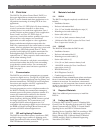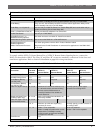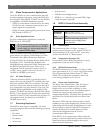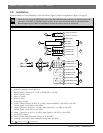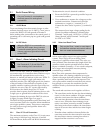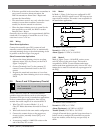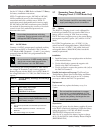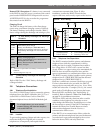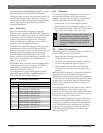
Bosch | 09/04 | 74-06200-000-F6
D2071A | Operations & Installation Guide |
1.6 Slave Communicator Applications
To use the D2071A as a slave communicator that only
provides signaling connections, connect the D2071A to
an existing UL Listed NFPA 72 FACP. Use the D2071A
in compliance with NFPA standards to provide:
• NFPA 72 central station connections for an existing
FACP when only a summary alarm and up to two
trouble signals are required, and
• NFPA 72 remote station signaling connections for an
FACP listed for NFPA 72.
1.6.1 Slave Application Power
For slave communicator applications, connect the
D2071A to a 24 VDC FACP.
Do not install a battery in this configuration.
Do not connect the D2071A to a 12 VDC
power supply or a control panel that only
provides 12 VDC output.
If the FACP does not provide a 24 VDC auxiliary
power output, you must use a D126 Battery, a D1220
Transformer, and a D8004 Transformer Enclosure.
If using the D2071AC, the Basler Electric Model A9115
Transformer (P/N: 58-06306-000) installed in the
D4103R Enclosure replaces the D1220 Transformer and
the D8004 Transformer Enclosure. This is a UL
recognized, Class II transformer rated for 20 VA at
12 VAC. It uses pigtails to hard wire directly to a
110 VAC or 120 VAC power source.
1.6.2 UL Listed Enclosure
Unless the monitored FACP is specifically listed or
approved for use with the D2071A installed in the same
enclosure, install the D2071A in a separate UL Listed
enclosure. Connect the separate enclosure to the FACP
by a conduit that is no more than 20 ft (6 m) long. The
D4103R, D8109, and D8108A are all suitable for this
purpose. The D2071AC includes a D4103R with a Basler
Electric, UL recognized, Class II, hard wire transformer
rated for 20 VA at 12 VAC mounted in the enclosure. It
uses pigtails to hard wire directly
to a 110 VAC or
120 VAC
power source.
1.7 Receiving Equipment
The D2071A must report to compatible, UL Listed
receiving equipment that meets the following processing
capabilities:
• Fire alarm
• System trouble
• Low battery
• 24-hour test
• System restoral
• 2300 Hz acknowledgment tone
• BFSK or 3 x 1, 40 pulses per second (PPS), single
round with parity (superfast)
1.8 D2071A Control Panel Assembly
1.8.1 Terminal Strip
The terminal strip (Item 1 in Figure 1 on page 7)
connects system wiring for power, ground, a Class “A”
Alarm Initiating Circuit, two Class “B” supervisory
circuits, and two Form “C” Relay outputs.
1.8.2 Programmer Connector (J3)
Connect the D5100 or D5200 Programmer to the J3
programmer connector (Item 2 in Figure 1).
1.8.3 D2071A Enclosure Cover
The D2071A Enclosure Cover (Item 3 in Figure 1) slides
open approximately 2 in. (5.1 cm) to expose the terminal
strip, programming jack, and two Form “C” Relay
sockets. You do not need to completely remove the
cover during installation or for service.
1.8.4 Phone Line Trouble Buzzer
The Phone Line Trouble Buzzer (Item 4 in Figure 1)
sounds when either the primary or the alternate
telephone line is in a trouble condition, or when
communications failure occurs. Ten failed attempts to
transmit any report puts the control panel in
communications failure. The Phone Line Trouble LED
and Phone Line Trouble Relay follow the Phone Line
Buzzer.
The buzzer, LED, and relay deactivate after a trouble
condition occurs on the telephone line and the receiver
acknowledges the Phone Line Trouble Report, or when
the line returns to normal. If the D2071A attempts to
transmit the Phone Line Trouble Report ten times
without acknowledgment from the receiver,
communication failure occurs.
If the D2071A is in communication failure, either the
primary or alternate telephone line must be detected as
normal and a report acknowledged by the receiver
before the buzzer deactivates.
1.0 Overview
Table 3: D2071A Dimensions
Dimensions
(H x W x D)
6.8 in. x 4.4 in. x 1.1 in.
(17.3 cm x 11.2 cm x 2.8 cm)
Color
Red
Construction
UL94V-O flame-rated, acrylonitrile
butadiene styrene (ABS) plastic,
non-conductive



